child lock BMW M6 CONVERTIBLE 2015 F12M Owner's Manual
[x] Cancel search | Manufacturer: BMW, Model Year: 2015, Model line: M6 CONVERTIBLE, Model: BMW M6 CONVERTIBLE 2015 F12MPages: 230, PDF Size: 4.9 MB
Page 50 of 230
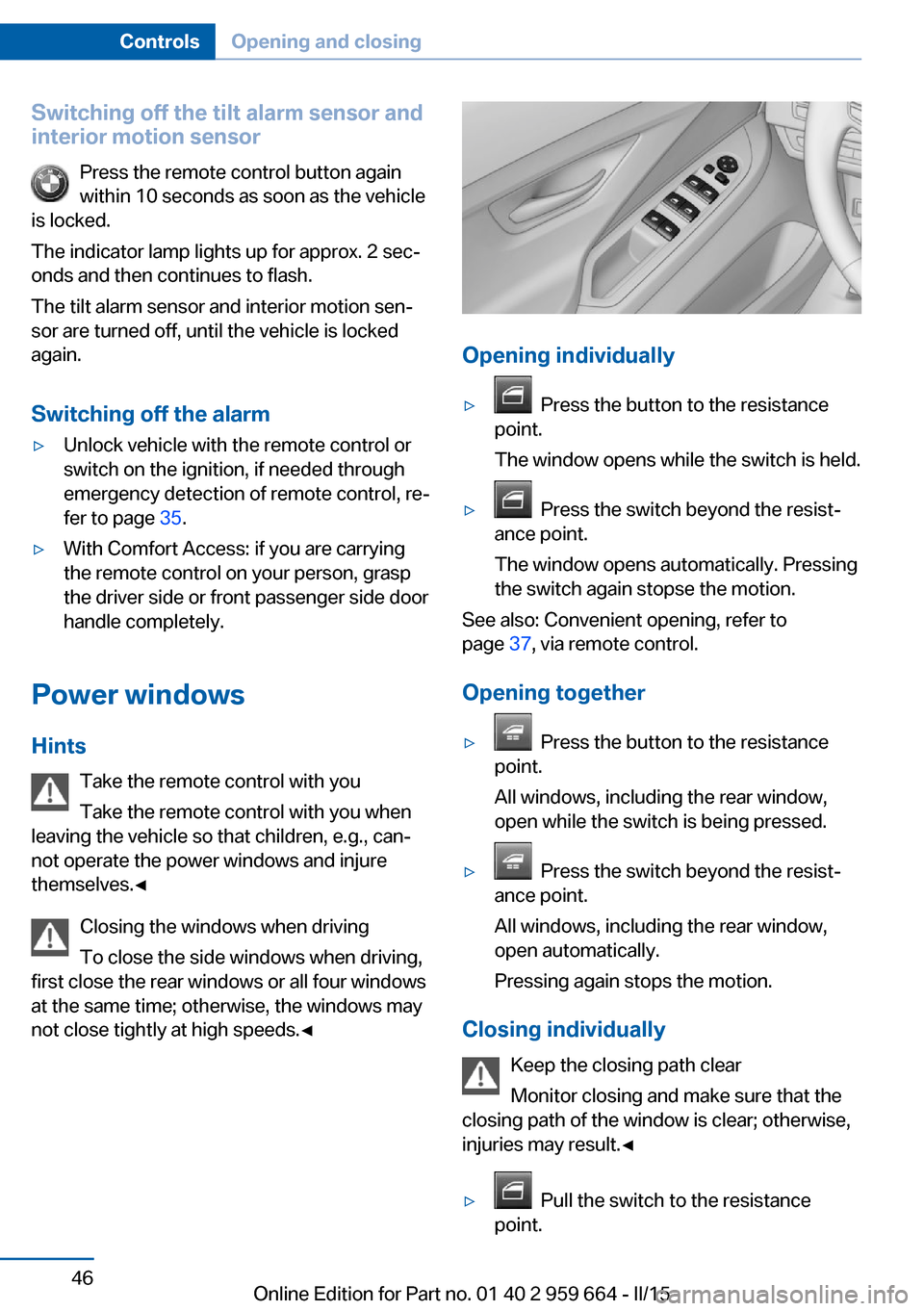
Switching off the tilt alarm sensor and
interior motion sensor
Press the remote control button again
within 10 seconds as soon as the vehicle
is locked.
The indicator lamp lights up for approx. 2 secā
onds and then continues to flash.
The tilt alarm sensor and interior motion senā
sor are turned off, until the vehicle is locked again.
Switching off the alarmā·Unlock vehicle with the remote control or
switch on the ignition, if needed through
emergency detection of remote control, reā
fer to page 35.ā·With Comfort Access: if you are carrying
the remote control on your person, grasp
the driver side or front passenger side door
handle completely.
Power windows
Hints Take the remote control with youTake the remote control with you when
leaving the vehicle so that children, e.g., canā
not operate the power windows and injure
themselves.ā
Closing the windows when driving
To close the side windows when driving,
first close the rear windows or all four windows
at the same time; otherwise, the windows may
not close tightly at high speeds.ā
Opening individually
ā· Press the button to the resistance
point.
The window opens while the switch is held.ā· Press the switch beyond the resistā
ance point.
The window opens automatically. Pressing
the switch again stopse the motion.
See also: Convenient opening, refer to
page 37, via remote control.
Opening together
ā· Press the button to the resistance
point.
All windows, including the rear window,
open while the switch is being pressed.ā· Press the switch beyond the resistā
ance point.
All windows, including the rear window,
open automatically.
Pressing again stops the motion.
Closing individually
Keep the closing path clear
Monitor closing and make sure that the
closing path of the window is clear; otherwise,
injuries may result.ā
ā· Pull the switch to the resistance
point.
Seite 46ControlsOpening and closing46
Online Edition for Part no. 01 40 2 959 664 - II/15
Page 53 of 230

Allow wet convertible top to dry
Do not leave the open convertible top in
the convertible top well longer than one day
while the top is still wet; otherwise, damage
could result due to moisture.ā
Note the swivel range of the convertible
top
The convertible top pivots up during opening
and closing. When the top is moved, e.g., in
garages, make sure that there is a minimum
height of 79 inches/2 meters; otherwise, it
damages may result.ā
Do not place objects on the convertible
top
Do not place any objects on the convertible
top, otherwise, they could fall and cause damā
age or injuries.ā
No convertible top movement when rollā
over protection is activated
Do not move the convertible top when rollover
protection is activated; otherwise, it may result
in damage to the convertible top.ā
Open and close convertible top comā
pletely
Always open or close the convertible top comā
pletely. Convertible top and convertible top
well storage cover are locked in the final posiā
tions. Driving with the convertible top or
convertible top well storage cover unlocked
can result in damage.ā
Do not reach into the convertible top
mechanism
Do not reach into the convertible top mechaā
nism during the opening and closing operation.
Keep children away from the opening path of
the convertible top, otherwise, there is a risk of injury.āObserve traffic during operation
When the convertible top is opened while
driving, be alert to traffic; otherwise, it may reā
sult in an accident. If possible, do not move the
convertible top while driving in reverse beā
cause rearward vision is severely impaired
while the convertible top is in motion. During
windy conditions, do not operate the
convertible top while driving.
Do not drive faster than 30 mph/50 km/h; othā
erwise, vehicle damage may occur.ā
Do not attach any roof carrier systems to
the convertible top
Do not attach any roof carrier systems; otherā
wise, an accident may occur.ā
Do not operate convertible top on unā
even sections or road
Do not open or close convertible top on unā
even sections of road. Otherwise, the vibraā
tions can result in damage to the convertible
top.ā
Before opening and closingā·Follow the safety instructions for the
convertible top.ā·Make sure that the trunk partition in the
trunk is folded down.ā·Make sure that the cargo does not push
against the trunk partition from below.ā·Make sure that the trunk lid is closed.
Opening and closing from the inside
In order to protect the battery, move the
convertible top only when the engine is runā
ning if possible.
Before closing the convertible top, remove any
foreign objects from the windshield frame; othā
erwise, closing may be prevented.
ā·Press and hold the switch. The
windows are rolled down, and theSeite 49Opening and closingControls49
Online Edition for Part no. 01 40 2 959 664 - II/15
Page 63 of 230
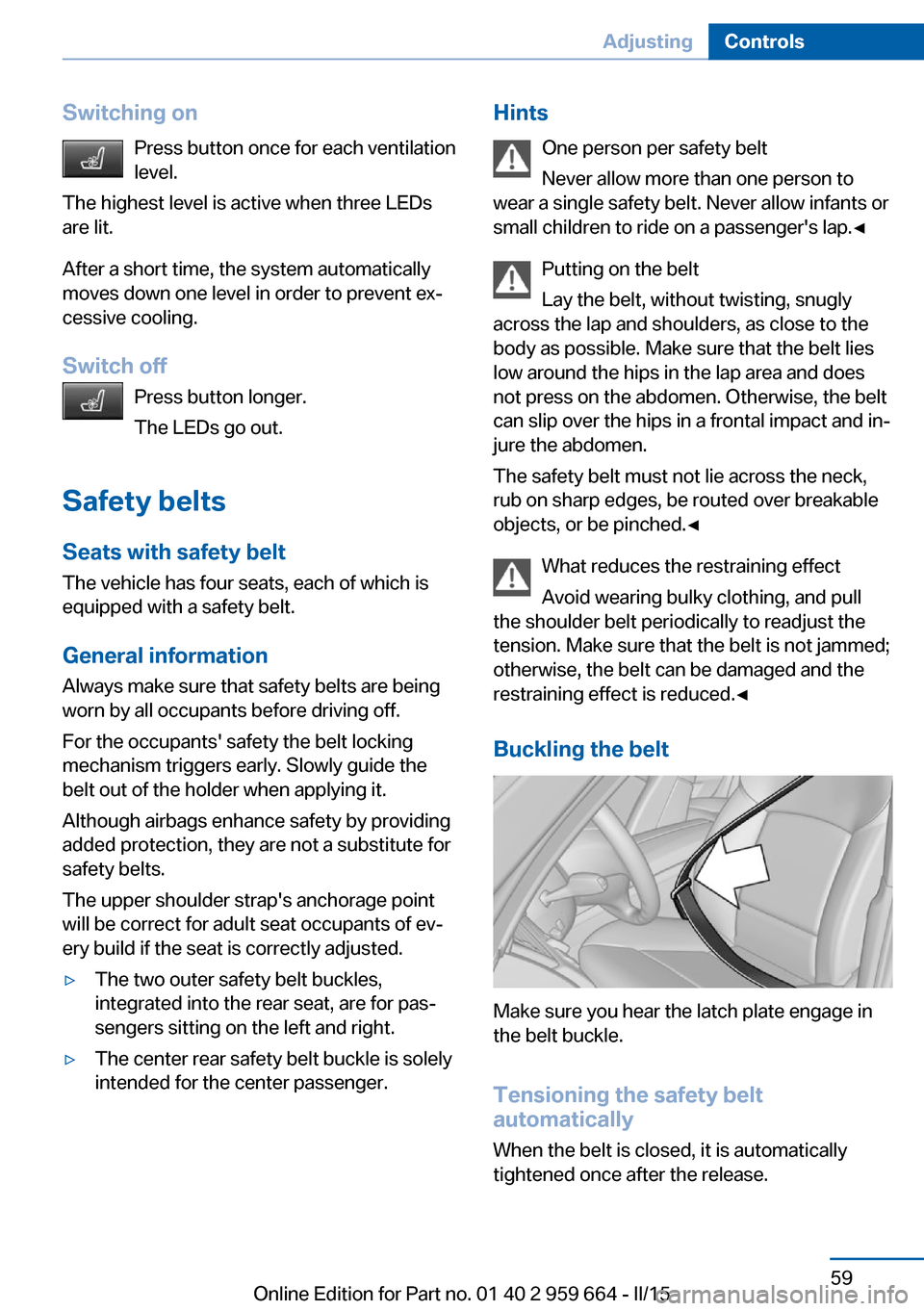
Switching onPress button once for each ventilation
level.
The highest level is active when three LEDs
are lit.
After a short time, the system automatically
moves down one level in order to prevent exā
cessive cooling.
Switch off Press button longer.
The LEDs go out.
Safety belts Seats with safety beltThe vehicle has four seats, each of which is
equipped with a safety belt.
General information
Always make sure that safety belts are being
worn by all occupants before driving off.
For the occupants' safety the belt locking
mechanism triggers early. Slowly guide the
belt out of the holder when applying it.
Although airbags enhance safety by providing
added protection, they are not a substitute for
safety belts.
The upper shoulder strap's anchorage point
will be correct for adult seat occupants of evā
ery build if the seat is correctly adjusted.ā·The two outer safety belt buckles,
integrated into the rear seat, are for pasā
sengers sitting on the left and right.ā·The center rear safety belt buckle is solely
intended for the center passenger.Hints
One person per safety belt
Never allow more than one person to
wear a single safety belt. Never allow infants or
small children to ride on a passenger's lap.ā
Putting on the belt
Lay the belt, without twisting, snugly
across the lap and shoulders, as close to the
body as possible. Make sure that the belt lies
low around the hips in the lap area and does
not press on the abdomen. Otherwise, the belt
can slip over the hips in a frontal impact and inā
jure the abdomen.
The safety belt must not lie across the neck,
rub on sharp edges, be routed over breakable
objects, or be pinched.ā
What reduces the restraining effect
Avoid wearing bulky clothing, and pull
the shoulder belt periodically to readjust the
tension. Make sure that the belt is not jammed;
otherwise, the belt can be damaged and the
restraining effect is reduced.ā
Buckling the belt
Make sure you hear the latch plate engage in
the belt buckle.
Tensioning the safety belt
automatically
When the belt is closed, it is automatically
tightened once after the release.
Seite 59AdjustingControls59
Online Edition for Part no. 01 40 2 959 664 - II/15
Page 70 of 230

Transporting children safelyVehicle features and optionsThis chapter describes all standard, country-
specific and optional features offered with the
series. It also describes features that are not
necessarily available in your car, e. g., due tothe selected options or country versions. This
also applies to safety-related functions and
systems. The respectively applicable country
provisions must be observed when using the
respective features and systems.
The right place for children
Note
Children in the vehicle
Do not leave children unattended in the
vehicle; otherwise, they could endanger themā
selves and other persons, e.g., by opening the
doors.ā
Children should always be in the rear Accident research shows that the safest place
for children is in the back seat.
Transporting children in the rear
Only transport children younger than
13 years of age or shorter than 5 ft/150 cm in
the rear in child restraint systems provided in
accordance with the age, weight and size of
the child; otherwise, there is an increased risk
of injury in an accident.
Children 13 years of age or older must wear a
safety belt as soon as a suitable child restraint
system can no longer be used due to their age,
weight and size.ā
Children on the front passenger seat
Should it ever be necessary to use a child reā
straint system in the front passenger seat,
make sure that the front, knee and side airbags
on the front passenger side are deactivated.
Automatic deactivation of front-seat passenā
ger airbags, refer to page 108.Note
Deactivating the front-seat passenger
airbags
If a child restraint system is used in the front
passenger seat, deactivate the front-seat pasā
senger airbags; otherwise, there is an inā
creased risk of injury to the child when the airā
bags are activated, even with a child restraint
system.ā
Installing child restraint
systems
Hints Manufacturer's information for child reāstraint systems
To select, mount and use child restraint sysā
tems, observe the information provided by the
system manufacturer; otherwise, the protecā
tive effect can be lost.ā
Ensuring the stability of the child seat
When installing child restraint systems,
make sure that the child seat is securely fasā
tened to the backrest of the seat. Angle and
headrest of the backrest might need to be adā
justed or possibly be removed. Make sure that
all backrests are securely locked. Otherwise
the stability of the child seat can be affected,
and there is an increased risk of injury becauseSeite 66ControlsTransporting children safely66
Online Edition for Part no. 01 40 2 959 664 - II/15
Page 71 of 230
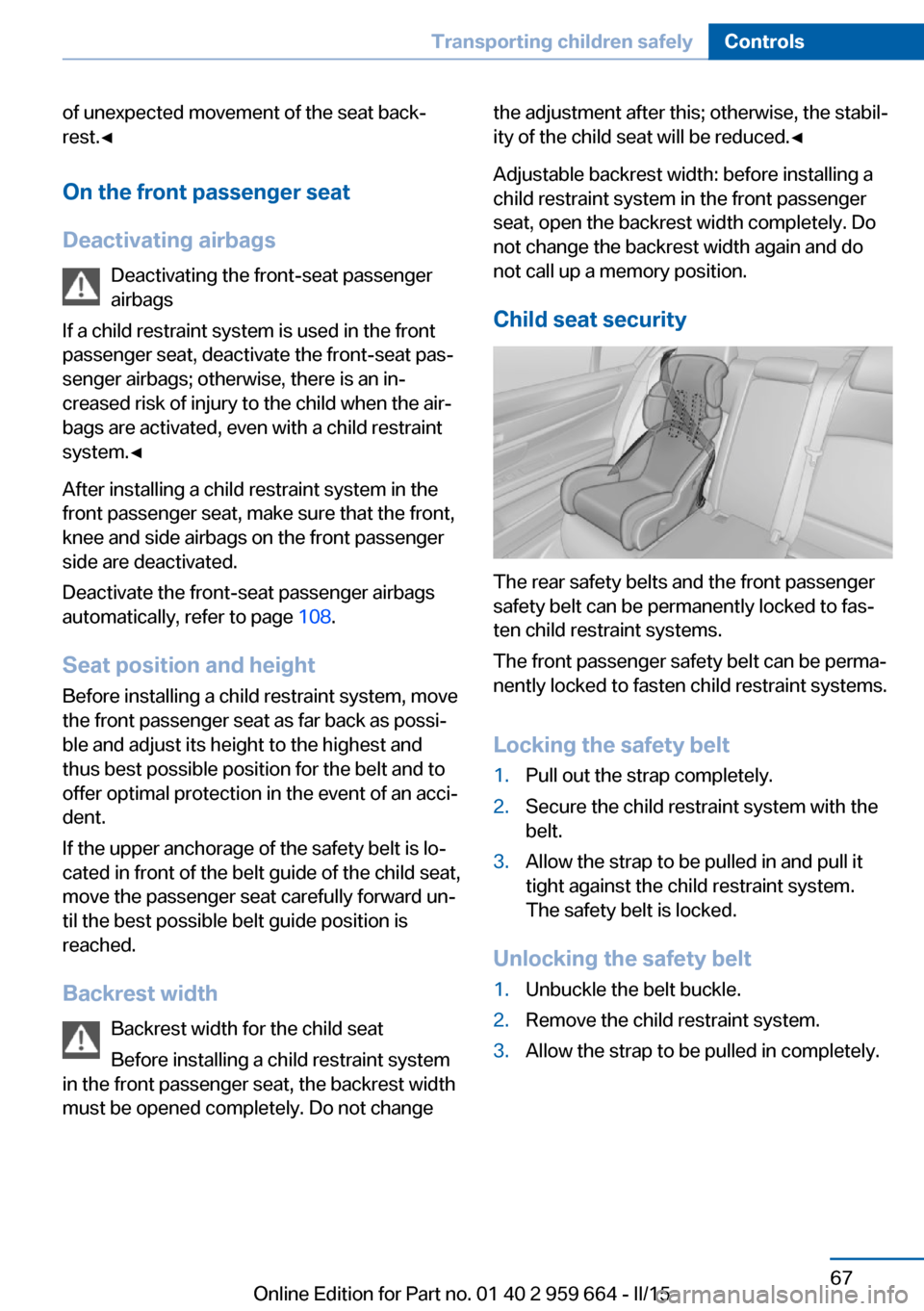
of unexpected movement of the seat backā
rest.ā
On the front passenger seat
Deactivating airbags Deactivating the front-seat passenger
airbags
If a child restraint system is used in the front
passenger seat, deactivate the front-seat pasā
senger airbags; otherwise, there is an inā
creased risk of injury to the child when the airā
bags are activated, even with a child restraint
system.ā
After installing a child restraint system in the
front passenger seat, make sure that the front,
knee and side airbags on the front passenger
side are deactivated.
Deactivate the front-seat passenger airbags automatically, refer to page 108.
Seat position and height
Before installing a child restraint system, move
the front passenger seat as far back as possiā
ble and adjust its height to the highest and
thus best possible position for the belt and to
offer optimal protection in the event of an acciā
dent.
If the upper anchorage of the safety belt is loā
cated in front of the belt guide of the child seat,
move the passenger seat carefully forward unā
til the best possible belt guide position is
reached.
Backrest width Backrest width for the child seat
Before installing a child restraint system
in the front passenger seat, the backrest width
must be opened completely. Do not changethe adjustment after this; otherwise, the stabilā
ity of the child seat will be reduced.ā
Adjustable backrest width: before installing a
child restraint system in the front passenger
seat, open the backrest width completely. Do
not change the backrest width again and do
not call up a memory position.
Child seat security
The rear safety belts and the front passenger
safety belt can be permanently locked to fasā
ten child restraint systems.
The front passenger safety belt can be permaā
nently locked to fasten child restraint systems.
Locking the safety belt
1.Pull out the strap completely.2.Secure the child restraint system with the
belt.3.Allow the strap to be pulled in and pull it
tight against the child restraint system.
The safety belt is locked.
Unlocking the safety belt
1.Unbuckle the belt buckle.2.Remove the child restraint system.3.Allow the strap to be pulled in completely.Seite 67Transporting children safelyControls67
Online Edition for Part no. 01 40 2 959 664 - II/15
Page 74 of 230

The radio-ready state switches off automatiā
cally:ā·After approx. 8 minutes.ā·When the vehicle is locked using the cenā
tral locking system.ā·Shortly before the battery is discharged
completely, so that the engine can still be
started.
The radio-ready state remains active if, e.g.,
the ignition is automatically switched off for the
following reasons:
ā·Opening or closing the driver's door.ā·Unfastening of the driver's safety belt.ā·When automatically switching from low
beams to parking lights.
If the engine is switched off and the ignition is
switched on, the system automatically
switches to the radio-ready state if the lights
are turned off or, if correspondingly equipped,
the daytime running lights are activated.
Starting the engine
Hints Enclosed areas
Do not let the engine run in enclosed
areas, since breathing in exhaust fumes may
lead to loss of consciousness and death. The
exhaust gases contain carbon monoxide, an
odorless and colorless but highly toxic gas.ā
Unattended vehicle
Do not leave the vehicle unattended with
the engine running; doing so poses a risk of
danger.
Before leaving the vehicle with the engine runā
ning, set the parking brake and engage transā
mission position P; otherwise, the vehicle may
begin to move.ā
Repeated starting in quick succession
Avoid trying to start the vehicle repeatā
edly and in quick succession. Otherwise, the
fuel is not burned or is inadequately burned,
posing a risk of overheating and damage to the
catalytic converter.ā
Do not wait for the engine to warm-up while
the vehicle remains stationary. Start driving at
moderate engine speeds.
M double-clutch transmission
Starting the engine1.Depress the brake pedal.2.Press the Start/Stop button.
The ignition is activated automatically for a
certain time and is stopped as soon as the enā
gine starts.
Manual transmission
Starting the engine
1.Depress the brake pedal.2.Press on the clutch pedal and shift to neuā
tral.3.Press the Start/Stop button.
The ignition is activated automatically for a
certain time and is stopped as soon as the enā
gine starts.
Engine stop
Hints Take the remote control with you
Take the remote control with you when
leaving the vehicle so that children, e.g., canā
not start the engine.ā
Apply parking brake and further secure
the vehicle if needed.
Set the parking brake firmly when parking; othā
erwise, the vehicle could roll. On steep upward
Seite 70ControlsDriving70
Online Edition for Part no. 01 40 2 959 664 - II/15
Page 221 of 230
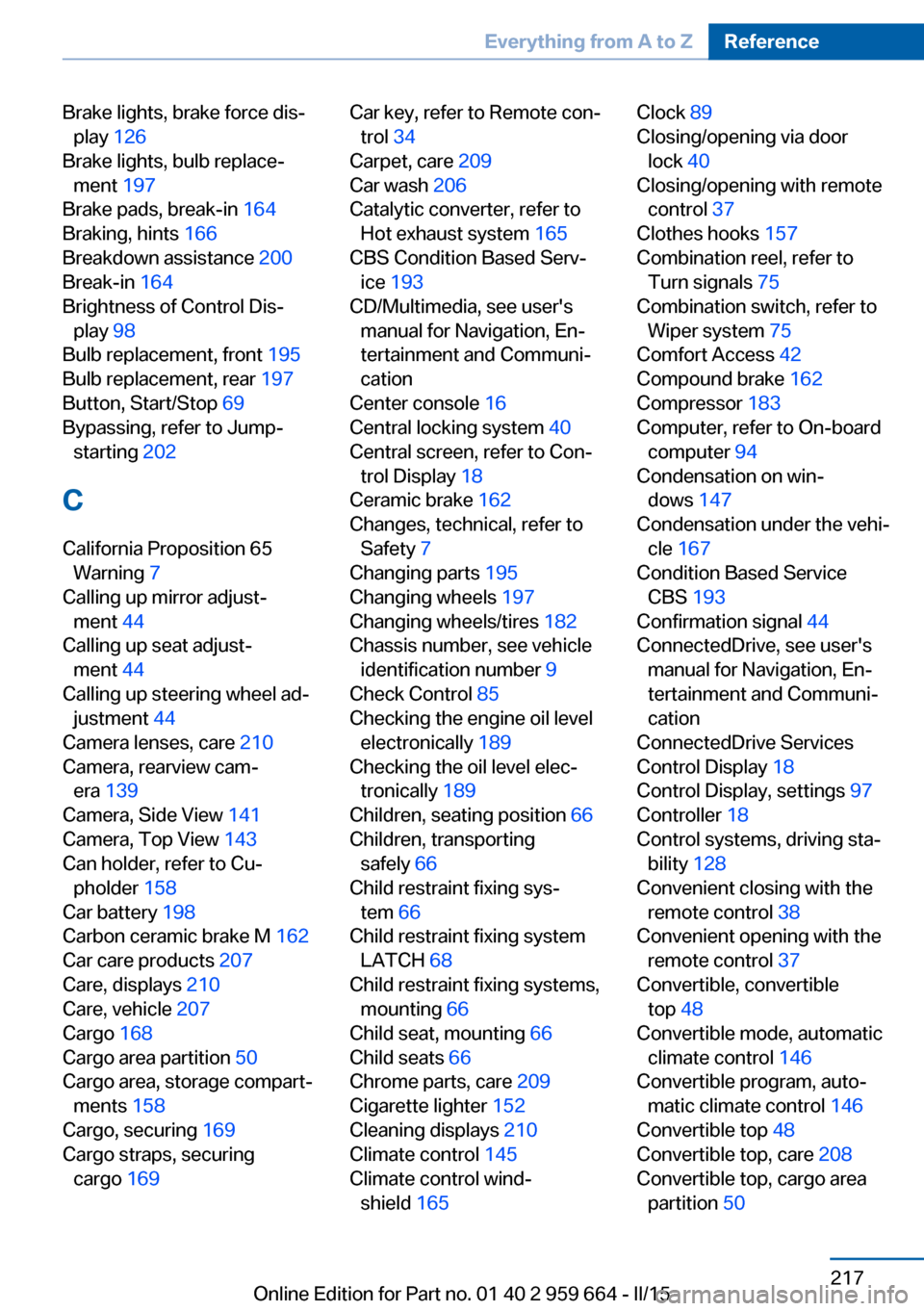
Brake lights, brake force disāplay 126
Brake lights, bulb replaceā ment 197
Brake pads, break-in 164
Braking, hints 166
Breakdown assistance 200
Break-in 164
Brightness of Control Disā play 98
Bulb replacement, front 195
Bulb replacement, rear 197
Button, Start/Stop 69
Bypassing, refer to Jump- starting 202
C
California Proposition 65 Warning 7
Calling up mirror adjustā ment 44
Calling up seat adjustā ment 44
Calling up steering wheel adā justment 44
Camera lenses, care 210
Camera, rearview camā era 139
Camera, Side View 141
Camera, Top View 143
Can holder, refer to Cuā pholder 158
Car battery 198
Carbon ceramic brake M 162
Car care products 207
Care, displays 210
Care, vehicle 207
Cargo 168
Cargo area partition 50
Cargo area, storage compartā ments 158
Cargo, securing 169
Cargo straps, securing cargo 169 Car key, refer to Remote conā
trol 34
Carpet, care 209
Car wash 206
Catalytic converter, refer to Hot exhaust system 165
CBS Condition Based Servā ice 193
CD/Multimedia, see user's manual for Navigation, Enā
tertainment and Communiā
cation
Center console 16
Central locking system 40
Central screen, refer to Conā trol Display 18
Ceramic brake 162
Changes, technical, refer to Safety 7
Changing parts 195
Changing wheels 197
Changing wheels/tires 182
Chassis number, see vehicle identification number 9
Check Control 85
Checking the engine oil level electronically 189
Checking the oil level elecā tronically 189
Children, seating position 66
Children, transporting safely 66
Child restraint fixing sysā tem 66
Child restraint fixing system LATCH 68
Child restraint fixing systems, mounting 66
Child seat, mounting 66
Child seats 66
Chrome parts, care 209
Cigarette lighter 152
Cleaning displays 210
Climate control 145
Climate control windā shield 165 Clock 89
Closing/opening via door lock 40
Closing/opening with remote control 37
Clothes hooks 157
Combination reel, refer to Turn signals 75
Combination switch, refer to Wiper system 75
Comfort Access 42
Compound brake 162
Compressor 183
Computer, refer to On-board computer 94
Condensation on winā dows 147
Condensation under the vehiā cle 167
Condition Based Service CBS 193
Confirmation signal 44
ConnectedDrive, see user's manual for Navigation, Enā
tertainment and Communiā
cation
ConnectedDrive Services
Control Display 18
Control Display, settings 97
Controller 18
Control systems, driving staā bility 128
Convenient closing with the remote control 38
Convenient opening with the remote control 37
Convertible, convertible top 48
Convertible mode, automatic climate control 146
Convertible program, autoā matic climate control 146
Convertible top 48
Convertible top, care 208
Convertible top, cargo area partition 50 Seite 217Everything from A to ZReference217
Online Edition for Part no. 01 40 2 959 664 - II/15
Page 224 of 230

IIce warning, see External temperature warning 89
Icy roads, see External temā perature warning 89
Identification marks, tires 179
Identification number, see veā hicle identification numā
ber 9
iDrive 18
Ignition key, refer to Remote control 34
Ignition off 69
Ignition on 69
Indication of a flat tire 111 , 113
Indicator and alarm lamps, see Check Control 85
Indicator lamp, see Check Control 85
Individual air distribution 146
Individual settings, refer to M Drive 128
Individual settings, refer to Personal Profile 35
Inflation pressure, tires 178
Inflation pressure warning FTM, tires 112
Info display, refer to On- Board computer 94
Initialize, Tire Pressure Moniā tor TPM 111
Initializing, Flat Tire Monitor FTM 113
Instrument cluster 84
Instrument cluster, electronic displays 84
Instrument lighting 104
Integrated key 34
Integrated Owner's Manual in the vehicle 29
Intelligent Emergency Reā quest 200
Intelligent Safety 113 Intensity, AUTO proā
gram 146
Interior equipment 150
Interior lights 104
Interior lights during unlockā ing 37
Interior lights with the vehicle locked 38
Interior motion sensor 45
Interior rearview mirror, autoā matic dimming feature 64
Internet page 6
Interval display, service reā quirements 91
Interval mode 76
J
Jacking points for the vehicle jack 198
Jump-starting 202
K
Key/remote control 34
Keyless Go, refer to Comfort Access 42
Key Memory, refer to Perā sonal Profile 35
Knee airbag 106
L Lamp replacement, front 195
Lamp replacement, rear 197
Lane departure warning 123
Lane margin, warning 123
Language on Control Disā play 98
Lashing eyes, securing cargo 169
LATCH child restraint sysā tem 68
Launch Control 81
Leather, care 208 LED headlights, bulb replaceā
ment 196
LED light 196
LEDs, light-emitting diā odes 196
Length, vehicle 214
Letters and numbers, enterā ing 24
License plate lamp, bulb reā placement 197
Light alloy wheels, care 209
Light control 102
Light-emitting diodes, LEDs 196
Lighting 101
Lighting, speaker 105
Lights 101
Lights and bulbs 195
Light switch 101
Load 169
Loading 168
Lock, door 40
Locking/unlocking via door lock 40
Locking/unlocking with reā mote control 37
Locking, automatic 44
Locking, settings 43
Locking via trunk lid 41
Low beams 101
Low beams, automatic, refer to High-beam Assistant 103
Lower back support 57
Low Speed Assistant 79
Lumbar support 57
M
Maintenance 193
Maintenance requireā ments 193
Maintenance, service requireā ments 91
Maintenance system, BMW 193
Make-up mirror 152 Seite 220ReferenceEverything from A to Z220
Online Edition for Part no. 01 40 2 959 664 - II/15
Page 225 of 230
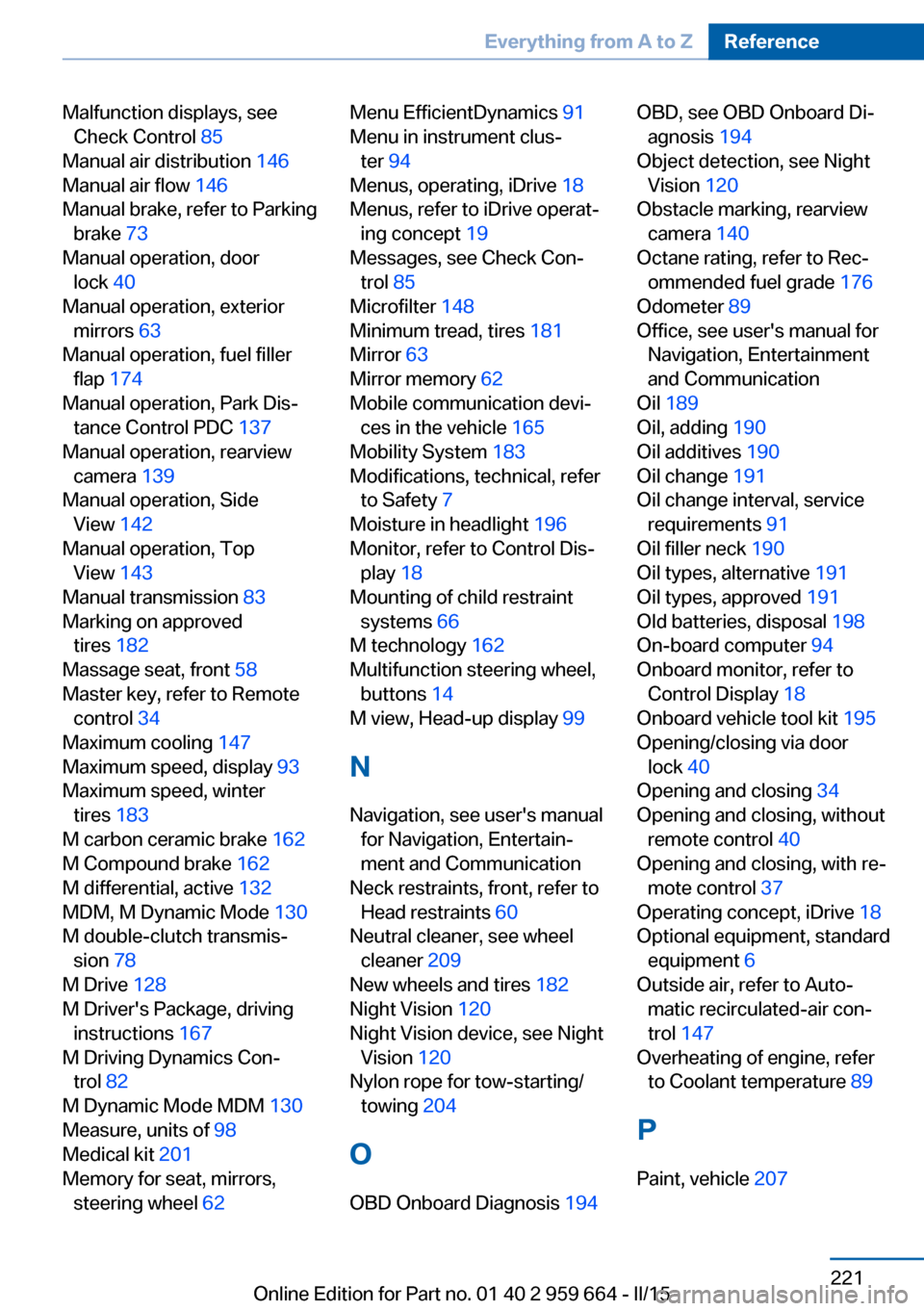
Malfunction displays, seeCheck Control 85
Manual air distribution 146
Manual air flow 146
Manual brake, refer to Parking brake 73
Manual operation, door lock 40
Manual operation, exterior mirrors 63
Manual operation, fuel filler flap 174
Manual operation, Park Disā tance Control PDC 137
Manual operation, rearview camera 139
Manual operation, Side View 142
Manual operation, Top View 143
Manual transmission 83
Marking on approved tires 182
Massage seat, front 58
Master key, refer to Remote control 34
Maximum cooling 147
Maximum speed, display 93
Maximum speed, winter tires 183
M carbon ceramic brake 162
M Compound brake 162
M differential, active 132
MDM, M Dynamic Mode 130
M double-clutch transmisā sion 78
M Drive 128
M Driver's Package, driving instructions 167
M Driving Dynamics Conā trol 82
M Dynamic Mode MDM 130
Measure, units of 98
Medical kit 201
Memory for seat, mirrors, steering wheel 62 Menu EfficientDynamics 91
Menu in instrument clusā ter 94
Menus, operating, iDrive 18
Menus, refer to iDrive operatā ing concept 19
Messages, see Check Conā trol 85
Microfilter 148
Minimum tread, tires 181
Mirror 63
Mirror memory 62
Mobile communication deviā ces in the vehicle 165
Mobility System 183
Modifications, technical, refer to Safety 7
Moisture in headlight 196
Monitor, refer to Control Disā play 18
Mounting of child restraint systems 66
M technology 162
Multifunction steering wheel, buttons 14
M view, Head-up display 99
N
Navigation, see user's manual for Navigation, Entertainā
ment and Communication
Neck restraints, front, refer to Head restraints 60
Neutral cleaner, see wheel cleaner 209
New wheels and tires 182
Night Vision 120
Night Vision device, see Night Vision 120
Nylon rope for tow-starting/ towing 204
O OBD Onboard Diagnosis 194 OBD, see OBD Onboard Diā
agnosis 194
Object detection, see Night Vision 120
Obstacle marking, rearview camera 140
Octane rating, refer to Recā ommended fuel grade 176
Odometer 89
Office, see user's manual for Navigation, Entertainment
and Communication
Oil 189
Oil, adding 190
Oil additives 190
Oil change 191
Oil change interval, service requirements 91
Oil filler neck 190
Oil types, alternative 191
Oil types, approved 191
Old batteries, disposal 198
On-board computer 94
Onboard monitor, refer to Control Display 18
Onboard vehicle tool kit 195
Opening/closing via door lock 40
Opening and closing 34
Opening and closing, without remote control 40
Opening and closing, with reā mote control 37
Operating concept, iDrive 18
Optional equipment, standard equipment 6
Outside air, refer to Autoā matic recirculated-air conā
trol 147
Overheating of engine, refer to Coolant temperature 89
P Paint, vehicle 207 Seite 221Everything from A to ZReference221
Online Edition for Part no. 01 40 2 959 664 - II/15
Page 228 of 230

Tow truck 203
TPM Tire Pressure Moniā tor 110
Transmission, manual transā mission 83
Transporting children safely 66
Tread, tires 181
Trip computer 96
Triple turn signal activaā tion 75
Trip odometer 89
Truck for tow-starting/ towing 203
Trunk, cargo area partition 50
Trunk lid closing 41
Trunk lid, emergency unlockā ing 42
Trunk lid, hotel function 41
Trunk lid opening 41
Trunk lid via remote conā trol 39
Turning circle 214
Turning circle lines, rearview camera 140
Turn signals, operation 75
Turn signals, rear, bulb reā placement 197
U
Unintentional alarm 45
Units of measure 98
Universal remote control 150
Unlocking/locking via door lock 40
Unlocking/locking with reā mote control 37
Unlocking, settings 43
Updates made after the editoā rial deadline 7
Upholstery care 208
USB interface 156 V
V8 high-performance engine, High-performance engine
V8 162
Vanity mirror 152
Vehicle battery 198
Vehicle battery, replacā ing 198
Vehicle, break-in 164
Vehicle care 207
Vehicle features and opā tions 6
Vehicle identification numā ber 9
Vehicle jack 198
Vehicle paint 207
Vehicle storage 210
Vehicle wash 206
Ventilation 149
Ventilation, refer to Parked- car ventilation 149
Venting, see ventilation 149
Vent, see ventilation 149
VIN, see vehicle identification number 9
Voice activation system 26
W Warning and indicator lamps, see Check Control 85
Warning displays, see Check Control 85
Warning messages, see Check Control 85
Warning triangle 201
Warranty 7
Washer fluid 77
Washer nozzles, windā shield 77
Washer system 75
Washing, vehicle 206
Water on roads 166
Weights 214 Welcome lamps during unā
locking 37
Welcome lights 101
Wheel base, vehicle 214
Wheel cleaner 209
Wheels, changing 182
Wheels, everything on wheels and tires 178
Wheels, Flat Tire Monitor FTM 112
Wheels, Tire Pressure Moniā tor TPM 110
Width, vehicle 214
Wind deflector 54
Window defroster, rear 147
Windows, powered 46
Windshield, climate conā trol 165
Windshield washer fluid 77
Windshield washer nozā zles 77
Windshield washer sysā tem 75
Windshield wiper 75
Winter storage, care 210
Winter tires, suitable tires 183
Winter tires, tread 181
Wiper 75
Wiper blades, replacing 195
Wiper fluid 77
Wiper, fold-out position 77
Wiper system 75
Wood, care 209
Word match concept, navigaā tion 24
Wrench, see Onboard vehicle tool kit 195 Seite 224ReferenceEverything from A to Z224
Online Edition for Part no. 01 40 2 959 664 - II/15